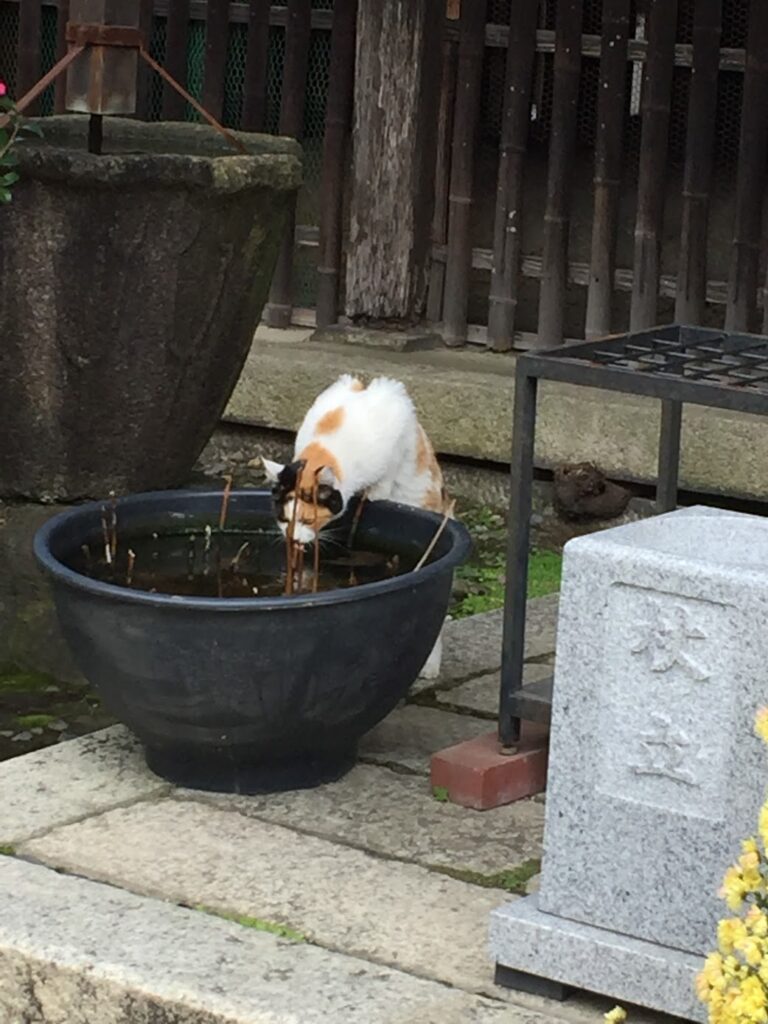by Sara Ackerman Aoyama
A Murder on Teramachi Street is a work in progress with plans for at least three more books to create a series. In this excerpt, Keiko who is the owner of a small restaurant called Den on Teramachi Street chats with an old friend who is a regular customer. After some amount of dithering, Keiko had rushed out to the grocer just down the street to purchase a few items. She had left the restaurant unlocked.
“Good morning, Emiko.”
Emiko, sitting at the counter, turned to the door when she heard the bells jingle and shook her head in consternation as Keiko hurried inside.
“Keiko, you left your shop door open! You are getting forgetful in your old age. Kyoto isn’t so safe that you can just leave your shop open anymore,” she scolded.
“Emiko, have you forgotten that we are exactly the same age?” Keiko replied tartly. “Are you calling yourself old then as well?”
“Most of our friends are grandmothers now,” she grumbled. “Let’s just admit that we’re old. Anyway, I’m glad you’re back. In gratitude for minding the shop, I think you should treat me to a cup of tea.”
“Hai, hai. I’ll get right to it. And Emiko, it was for your sake that I rushed out. I was fresh out of lemons for your tea so I trotted over to Mr. Morita’s to get them.
Knowing that Emiko would stop by, knowing she’d want lemon tea—and ensuring that she had a lemon on hand—was an example of omoiyari. It was a concept that she always enjoyed explaining to foreign students in Kyoto. There was no exact word for it in English and she felt it needed to be demonstrated to understand the true meaning. Though some people said it could translate as empathy, Keiko thought that omoiyari was more action-oriented. She thought of it as the result of careful consideration and anticipation of what would brighten a day or make someone feel good. Simply put, it was quietly taking action to make things go smoothly. If Keiko didn’t have omoiyari she would have just explained to Emiko that she had no lemons today, and that she could drink her tea with milk or sugar instead. How inconsiderate!
Keiko retied her apron and began making a cup of tea for Emiko. While she was doing that, two young women who worked in an office building a few doors down came in, sat down at a table by the window, and also wanted lemon tea with their morning set. Keiko was glad she had bought more than one lemon. She set out three cups and then thought for a second and took out a fourth. She’d have a cup of coffee as she chatted with Emiko. Emiko had switched seats at the counter to be closer to where Keiko was doing her prep work. The wooden counter was chipped with age, but it still shone nicely when she polished it each morning. It could seat up to eight people, though there were rarely more than six people even during lunch when Keiko was at her busiest. She heard the back door open as her cook, Minoru Tsuji, arrived. She served the lemon tea, measured out the coffee beans for her own coffee, and then went into the kitchen to greet Minoru.
“Ohayo gozaimasu. It’s a beautiful morning, isn’t it.”
Her young bearded cook returned her greeting and nodded his head in agreement, as he chopped up some onions.
“For lunch today I was thinking we could serve Chicken Piccata and I’ve already picked up the lemons to garnish it.”
“Did you get parsley? If we’re cooking western style chicken we’ll need that too as a garnish.”
The lunch menu at Den was filled with Western-style dishes such as Napolitan spaghetti, omuraisu, curry, and a Japanese hamburger plate. Yōshoku or Western food had been introduced into Japan during the Meiji Era and became more prevalent after World War II. In a sense, Keiko and her menu were both relics of past years, but she liked it that way. Yōshoku was more of a fusion style of food since it had been influenced by what was available in Japan and the palette of the Japanese people. For example, the curry served all over Japan was generally mild. Napolitan spaghetti was made with ketchup instead of tomato sauce. Some people thought yōshoku was embarrassing now that Japan had plenty of authentic restaurants serving foreign cuisine. But people of Keiko’s generation, who’d grown up with it, still enjoyed it and young people had recently “rediscovered” it so it was having its moment once again.
Her dinner menu was the same as the lunch menu, but lunch was her busiest time of the day. Her late husband had bolstered business by serving beer and sake in the evenings, but it was too much for Keiko to handle on her own, and rather than hire someone to serve drinks, she’d close the restaurant after dinner.
Den had always been a neighborhood place and even with tourists filling the area it retained that character. The wooden tables and chairs were a little wobbly and didn’t have even a whisper of chic to them. It simply wasn’t flashy or intriguing enough for tourists. But different restaurants were always being highlighted in Kyoto tourist magazines and on television programs. She dreaded the day when her restaurant might appear in a trendy article called “Ten Hidden Places in Kyoto That You Must See.” Or something like that. Social media was all over Kyoto and fed off the tourism boom.
Keiko opened the refrigerator to show Minoru the parsley. She was pleased that she’d remembered the parsley and mentally congratulated herself. Maybe she wasn’t yet over the hill after all. She walked out of the kitchen and finished making her coffee.
Though Den had no claims to pretension and wasn’t one of these upscale coffee shops, she still brewed coffee cup by cup as her husband had since the shop opened in the late 1970’s. First, she’d weigh the coffee beans on a small scale that they’d been using ever since she could remember. Then she’d grind the coffee by hand. She knew she was old-fashioned. But her husband had insisted that grinding by hand was the right treatment for coffee beans and she wasn’t inclined to go out and buy a fancy gadget. She also continued the tradition of making each cup fresh using the pour over method that every coffee shop in Kyoto used. That is, used to use. These days the chain stores would not use such a cumbersome and time-consuming method. It was all about volume and speed for them. But the traditional shops still made their coffee the old way. If you were in a hurry for coffee and your time was more important than the flavor then you’d best avoid places like Den.
Kyoto was known in Japan for its delicious coffee and pastries. Foreign tourists didn’t realize this, and even Japanese from other cities in Japan mostly remained ignorant of the preponderance of bakeries. Tourists came to Kyoto to see temples, shrines, autumn leaves, and cherry blossoms without knowing what Kyotoites knew about their city. Was that a good thing or a bad thing? This was something that the neighborhood association was pondering right now.
Tourism in Kyoto had increased rapidly over the last ten years. Keiko could remember back in the 1970’s when she knew most of the Westerners living in Kyoto, at least by sight. Of course most of them did not know her. She was just another Japanese face to them and very few of them would ever discover that she spoke English rather well. But nowadays English wasn’t the language you needed to speak to tourists since most of them were from China or Korea. They did not share a language, but they did share a common alphabet to some degree. A Westerner would have trouble telling a Chinese person from a Japanese person. As fellow Asians, perhaps they did look similar, though Keiko didn’t think so. And from a cultural standpoint they were worlds—perhaps universes—apart. Few Asian tourists ventured into Den. It wasn’t the kind of place that would attract them.
“Keiko, when is the next neighborhood association meeting?” Emiko’s words startled Keiko out of her reverie.
“I think it is next week. We have to review the new prefectural guidelines for tourists. Have you seen the new brochure they’ve published?”
“Is it in English? No, thank you.”
Emiko had what was known as an“English allergy.” Though she’d spent time abroad in Europe, she’d always gone on tours and had not needed to learn any foreign language other than a few polite greetings. Like many Japanese women her age, she’d studied English Conversation as a hobby in her younger years and had even majored in English Literature in college. When Keiko and Emiko were in junior college English Literature was the most popular major for girls. It was thought to be a nice addition to their marriage resume and showed intellect. Studying English Conversation was as much of a necessity as flower arranging and cooking back then. But most of the women of their generation had little confidence in their ability to speak English and avoided it as much as possible. Emiko was typical of her generation of women and felt she was hopeless with the language. She was not at all shy about expressing her dismay when she was called upon to communicate in English.
“The pamphlet is multilingual!” Keiko sighed at Emiko’s reaction.
Keiko was going to have to take the lead at the meeting. As more and more of her neighbors realized that she spoke English well and was comfortable with foreigners, they turned to her with questions and often sought her opinion. The neighborhood association was counting on her to help them adjust to this influx of tourists. Kyoto was flooded with tourists and Teramachi Street itself was surrounded by popular spots. While tourists might not deliberately come to their street, they’d certainly pass through it on their way to other areas. In fact, it was so conveniently located for tourism that a number of Airbnbs had sprung up.
The Teramachi Neighborhood Association was one of the older associations in Kyoto. Although Teramachi Street itself ran north to south through a large portion of the city, its character changed depending on the location. Keiko’s neighborhood was a shopping district of just 700 meters. It was bordered by City Hall on the south, and the Imperial Palace to the north. Teramachi, or “Temple Street,” was given that name because 400 years ago Toyotomi Hideyoshi moved the temples in the city to this street. Though the street was now home to more shops than temples, the north end of the street still held Gyoganji Temple (and a multitude of cats) which was across the street from a newer fancy hotel that was popular for wedding receptions. Emiko had told Keiko it was a “boutique hotel,” which amused Keiko. What on earth was that supposed to be? A code word for expensive, no doubt! What amused Keiko even more was that there were thirteen guest rooms. Hadn’t the architect or designer known that thirteen was considered an unlucky number in the West. Keiko had no idea why. In Japan, four was the unlucky number because it was pronounced “shi” which was the same word for death. No hospital had a fourth floor and no Japanese wanted a room on the fourth floor of a hotel. Or maybe times were changing. Keiko knew that the old hospital she’d given birth at in Kyoto certainly didn’t have a fourth floor.
“So, what’s in the brochure then?” asked Emiko.
“See for yourself. There are a few by the door.”










Recent Comments